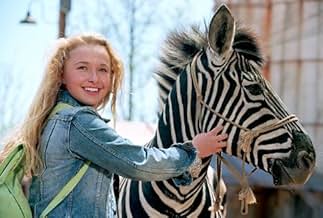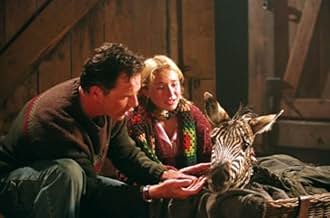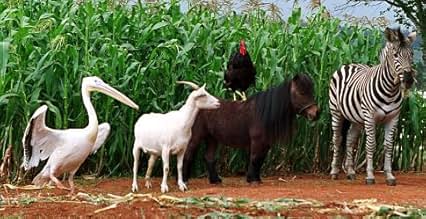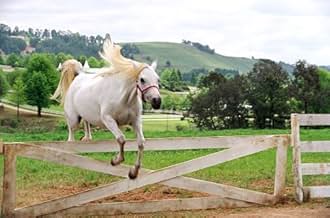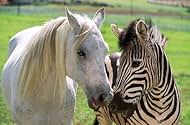IMDb रेटिंग
5.2/10
19 हज़ार
आपकी रेटिंग
अपनी भाषा में प्लॉट जोड़ेंAn abandoned zebra grows up believing he is a racehorse, and, with the help of his barnyard friends and a teenage girl, sets out to achieve his dream of racing with thoroughbreds.An abandoned zebra grows up believing he is a racehorse, and, with the help of his barnyard friends and a teenage girl, sets out to achieve his dream of racing with thoroughbreds.An abandoned zebra grows up believing he is a racehorse, and, with the help of his barnyard friends and a teenage girl, sets out to achieve his dream of racing with thoroughbreds.
- पुरस्कार
- 3 कुल नामांकन
फ़ीचर्ड समीक्षाएं
I thought this was a very funny movie. I laughed a lot and don't think that the jokes were too much (maybe the pecker joke). Someone said that the first 20 minutes were slow but OK to get used to the animation, but I think the animation was done really well and the race with the mailman is in there as well. The mailman was very cool ! (my father is a mailman, but this one is a lot more fun and hotter). I would have liked to see more with him. Hopefully he will be in more films.
The relationship between the father and the daughter could have been a little better, but the father and the zebra are nice together (with the training).
The story is a lot of fun for kids and families. My 5 year old loved it !! The horses are really beautiful. and so is the zebra (especially as a baby) I have never been to Kentucky, but I did not know it was not made in America, it looked beautiful.
All around I think you will like this movie !
The relationship between the father and the daughter could have been a little better, but the father and the zebra are nice together (with the training).
The story is a lot of fun for kids and families. My 5 year old loved it !! The horses are really beautiful. and so is the zebra (especially as a baby) I have never been to Kentucky, but I did not know it was not made in America, it looked beautiful.
All around I think you will like this movie !
Yes, it's stereotypical, and no, it doesn't reach or even approach the experience of Babe, but it is a fun flick, and one I feel is worth a matinée ticket if you're at all intrigued. I have to give kudos to the filmmakers for using real zebra sounds and vocalizations for Stripes; little details like that can make or break a talking animal film for the viewers who actually know a bit about the animals featured in a film...and hey, is it really too much to ask for a zebra to make zebra noises? There is some amount of potty humor, especially concerning the flies and the Jersey gangster pelican Goose, but it wasn't as much as I had assumed from earlier reviews.
There certainly are better movies out there, but the kids will enjoy this one, and the kid in me did. It was predictable, but comfortingly so, and sometimes it's nice to just sit back, suspend disbelief, and have a non-taxing movie experience where talking, wisecracking animals deliver lessons in life, like how being different isn't a bad thing, real winners are those with the heart to try, and success is often due to the support of those around you. And I do have to admit that one scene near the end brought tears to my eyes, much to my own surprise.
There certainly are better movies out there, but the kids will enjoy this one, and the kid in me did. It was predictable, but comfortingly so, and sometimes it's nice to just sit back, suspend disbelief, and have a non-taxing movie experience where talking, wisecracking animals deliver lessons in life, like how being different isn't a bad thing, real winners are those with the heart to try, and success is often due to the support of those around you. And I do have to admit that one scene near the end brought tears to my eyes, much to my own surprise.
If you strongly dislike films that are predictable, clichéd or derivative, and you're not showing Racing Stripes to kids, you should avoid this movie. Well, at least looking at things somewhat pessimistically. Ideally, you should sort out the conceptual errors you're making and see the movie, because it is a very good film. The Cult of Originality had it wrong. Artworks aren't inherently more valuable just because they're unprecedented, and they're not inherently less valuable just because they're engaging in a well-established form, or "template", to put it in more modern terms.
Stripes is a zebra who is orphaned at the beginning of the film when a traveling circus accidentally leaves him behind during a storm. Nolan Walsh (Bruce Greenwood) finds him and brings him back to his Kentucky farm (actually South Africa doubling as Kentucky). Walsh, a recent widower, has a teenaged daughter, Channing (Hayden Panettiere), who works at the local horse track for a mean, snooty and rich boss lady, Clara Dalrymple (Wendie Malick). The horse track is the heart of the town. The farm next door to the Walsh's breeds racehorses, and in fact, Walsh used to breed and train racehorses, too, for Clara, and it's implied that Walsh's wife, a former champion jockey, died in a horse-racing accident.
Meanwhile, Stripes is trying to adjust to life on the Walsh farm, which means assimilating with a motley crew of animals. All of the animals can talk to each other, "Mister Ed" (1961)-style, but in the more traditional filmic instantiation of talking animals, they can't talk to humans, although it is implied that they can at least slightly understand human speech. Stripes knows he looks different, but he figures he's a horse, like the racehorses next door, because that's what he looks closest to. Their teasing because he looks different merely creates a stronger desire for him to fit in and even best them, which naturally means a growing desire to race.
Any older cinephile could probably fill in the basic developments of the plot, up to and including the ending, given the premises above. The important consideration is not whether Racing Stripes is unprecedented, but how well it does what it sets out to do. The formulaic aspects of the plot, as with all artworks that engage with some traditional "formula", enhance Racing Stripes rather than detracting from it by (a) filling in a deep milieu of shared meaning, signifiers and so on, and (b) underscoring the ways in which Racing Stripes makes its variations on the form. It's a good film both because it executes the basics of the form so well and because the variations are well done, creative and entertaining. That's if you're an adult, at least. For younger audiences, it's a great film because it's establishing the form in their minds. The form exists as a template because it's a very effective, classic plot rooted in a particular kind of cultural mythology. But this instantiation is simply a funny, inspirational story featuring a talking zebra.
Filmic visual manipulation has come a long way in the 40 years since "Mister Ed". Mister Ed, the original talking horse, was made to "speak" by putting something in his mouth that he would then try to remove. In Racing Stripes, the animal speech is all done through cgi--actually computer animation/manipulation of cinematographic images of the animals' mouths, and it looks incredibly realistic. Like most movies of this sort, Racing Stripes is a pleasure to watch simply for its animal stunts. I suppose one can never get too old or intellectual to enjoy a dancing monkey, so to speak. There are a few instances of animal "stunts" being too dangerous for the animals--such as Stripes' wipeout, so these are animated with cgi, too, and they're integrated very well.
There are also two completely cgi-animated characters--flies named Buzz and Scuzz. These are the most consistently comic characters, although as flies, a lot of their visual humor, at least, hinges on jokes about things like garbage, discarded food, manure, and so on.
The animals are voiced by an all-star cast. Director Frederik Du Chau, in his first live-action film (and only his second film), does an excellent job creating performances from the animals that match the public personalities of the voices. Stripes is Frankie Muniz, and has his innocent precociousness. Dustin Hoffman is an older, small horse named Tucker who provides advice and inspiration, a bit like a cynical Buddha. Snoop Dogg is the family hound, naturally enough, and tends to lie on the porch, chilling out and making sarcastic remarks. Joe Pantoliano is Goose--he made a wrong turn in New Jersey and is now comically trying to pass himself off as a gangster. The flies are David Spade and Steve Harvey, with Spade doing his infamous manic-but-mellow naivety. The human cast is good, too, but they're really ancillary to the animals. Older cinephiles will especially delight in seeing M. Emmet Walsh as a rumpled "track-rat".
As a film primarily targeted at kids and younger teens (although it's certainly not enjoyable only to them--I'm middle-aged and have no kids), Racing Stripes has a couple "moral of the story" subtexts, and as usual, they're themes that not only kids can benefit from internalizing. The primary theme is acceptance of difference. Stripes is unlike any being the other animals have encountered, and naturally he is teased, made fun of, ostracized and even physically abused because of it. The gist of the plot is a demonstration that difference isn't negative. This is often interpreted as a racial theme, but it's really more general than that, applying to all kinds of differences. The other main theme, acceptance of loss and confrontation of the resultant depression, fear and anger, arrives via Walsh.
Cute, funny, heartwarming and a subtly surreal fantasy, Racing Stripes is a great example of why predictability just doesn't matter when it comes to making a good film.
Stripes is a zebra who is orphaned at the beginning of the film when a traveling circus accidentally leaves him behind during a storm. Nolan Walsh (Bruce Greenwood) finds him and brings him back to his Kentucky farm (actually South Africa doubling as Kentucky). Walsh, a recent widower, has a teenaged daughter, Channing (Hayden Panettiere), who works at the local horse track for a mean, snooty and rich boss lady, Clara Dalrymple (Wendie Malick). The horse track is the heart of the town. The farm next door to the Walsh's breeds racehorses, and in fact, Walsh used to breed and train racehorses, too, for Clara, and it's implied that Walsh's wife, a former champion jockey, died in a horse-racing accident.
Meanwhile, Stripes is trying to adjust to life on the Walsh farm, which means assimilating with a motley crew of animals. All of the animals can talk to each other, "Mister Ed" (1961)-style, but in the more traditional filmic instantiation of talking animals, they can't talk to humans, although it is implied that they can at least slightly understand human speech. Stripes knows he looks different, but he figures he's a horse, like the racehorses next door, because that's what he looks closest to. Their teasing because he looks different merely creates a stronger desire for him to fit in and even best them, which naturally means a growing desire to race.
Any older cinephile could probably fill in the basic developments of the plot, up to and including the ending, given the premises above. The important consideration is not whether Racing Stripes is unprecedented, but how well it does what it sets out to do. The formulaic aspects of the plot, as with all artworks that engage with some traditional "formula", enhance Racing Stripes rather than detracting from it by (a) filling in a deep milieu of shared meaning, signifiers and so on, and (b) underscoring the ways in which Racing Stripes makes its variations on the form. It's a good film both because it executes the basics of the form so well and because the variations are well done, creative and entertaining. That's if you're an adult, at least. For younger audiences, it's a great film because it's establishing the form in their minds. The form exists as a template because it's a very effective, classic plot rooted in a particular kind of cultural mythology. But this instantiation is simply a funny, inspirational story featuring a talking zebra.
Filmic visual manipulation has come a long way in the 40 years since "Mister Ed". Mister Ed, the original talking horse, was made to "speak" by putting something in his mouth that he would then try to remove. In Racing Stripes, the animal speech is all done through cgi--actually computer animation/manipulation of cinematographic images of the animals' mouths, and it looks incredibly realistic. Like most movies of this sort, Racing Stripes is a pleasure to watch simply for its animal stunts. I suppose one can never get too old or intellectual to enjoy a dancing monkey, so to speak. There are a few instances of animal "stunts" being too dangerous for the animals--such as Stripes' wipeout, so these are animated with cgi, too, and they're integrated very well.
There are also two completely cgi-animated characters--flies named Buzz and Scuzz. These are the most consistently comic characters, although as flies, a lot of their visual humor, at least, hinges on jokes about things like garbage, discarded food, manure, and so on.
The animals are voiced by an all-star cast. Director Frederik Du Chau, in his first live-action film (and only his second film), does an excellent job creating performances from the animals that match the public personalities of the voices. Stripes is Frankie Muniz, and has his innocent precociousness. Dustin Hoffman is an older, small horse named Tucker who provides advice and inspiration, a bit like a cynical Buddha. Snoop Dogg is the family hound, naturally enough, and tends to lie on the porch, chilling out and making sarcastic remarks. Joe Pantoliano is Goose--he made a wrong turn in New Jersey and is now comically trying to pass himself off as a gangster. The flies are David Spade and Steve Harvey, with Spade doing his infamous manic-but-mellow naivety. The human cast is good, too, but they're really ancillary to the animals. Older cinephiles will especially delight in seeing M. Emmet Walsh as a rumpled "track-rat".
As a film primarily targeted at kids and younger teens (although it's certainly not enjoyable only to them--I'm middle-aged and have no kids), Racing Stripes has a couple "moral of the story" subtexts, and as usual, they're themes that not only kids can benefit from internalizing. The primary theme is acceptance of difference. Stripes is unlike any being the other animals have encountered, and naturally he is teased, made fun of, ostracized and even physically abused because of it. The gist of the plot is a demonstration that difference isn't negative. This is often interpreted as a racial theme, but it's really more general than that, applying to all kinds of differences. The other main theme, acceptance of loss and confrontation of the resultant depression, fear and anger, arrives via Walsh.
Cute, funny, heartwarming and a subtly surreal fantasy, Racing Stripes is a great example of why predictability just doesn't matter when it comes to making a good film.
Racing Stripes tries to be like Babe, hoping to connect to audiences like the 1995 film had done. The new film has many of the same qualities, but it isn't as fresh, as witty, or as affecting as the pig starring film was. The concept of making animals talk is always tricky, and, for the most part, director Frederik Du Chau pulls it off. The animals' mouths move in a believable fashion, and the vocal cast is first-rate. The fault lies in the script), which doesn't believe that the animals have much worth saying to adult audience members. However, for the right demography (I am guessing pre-teen girls) this would be a nice film to sit and watch.
Not sure what those others are seeing or looking for in a movie... This is one of the best movies i have taken my two 12 year old's to in a long time. This movie was hilarious, it had jokes for all ages. At times you would hear the kids start laughing through the theater, but there were several time when the adults would start out the laughing. I laughed through the entire movie. My daughters have seen all of the other movies that this one is supposed to be copying, but (according to them) this is by far the best. This one will definitely be added to our DVD collection as soon as it become available!! Highly recommend this one for the whole family!!!
क्या आपको पता है
- ट्रिवियाHayden Panettiere stated that she was thrown off the zebra and placed in the hospital with a concussion, whiplash, and two damaged vertebrae.
- गूफ़A zebra's stripes are like fingerprints - no two are alike. In the montage of Channing training Stripes you can clearly see she is riding different zebras at different times.
- क्रेज़ी क्रेडिटThe Alcon logo stretches into a stripe which becomes stripes on a zebra which becomes branches of a tree in the first scene and the movie begins.
- कनेक्शनReferenced in ख़तरा!: एपिसोड #22.1 (2005)
- साउंडट्रैकThe Good, The Bad and The Ugly
Written by Ennio Morricone
टॉप पसंद
रेटिंग देने के लिए साइन-इन करें और वैयक्तिकृत सुझावों के लिए वॉचलिस्ट करें
- How long is Racing Stripes?Alexa द्वारा संचालित
विवरण
- रिलीज़ की तारीख़
- कंट्री ऑफ़ ओरिजिन
- आधिकारिक साइटें
- भाषा
- इस रूप में भी जाना जाता है
- Скажені перегони
- फ़िल्माने की जगहें
- उत्पादन कंपनी
- IMDbPro पर और कंपनी क्रेडिट देखें
बॉक्स ऑफ़िस
- बजट
- $3,00,00,000(अनुमानित)
- US और कनाडा में सकल
- $4,97,72,522
- US और कनाडा में पहले सप्ताह में कुल कमाई
- $1,39,20,052
- 16 जन॰ 2005
- दुनिया भर में सकल
- $9,07,54,475
- चलने की अवधि1 घंटा 42 मिनट
- रंग
- ध्वनि मिश्रण
- पक्ष अनुपात
- 1.85 : 1
इस पेज में योगदान दें
किसी बदलाव का सुझाव दें या अनुपलब्ध कॉन्टेंट जोड़ें







